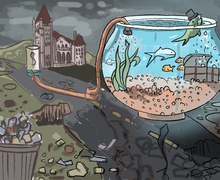Newhouse professor assists in efforts to track Ebola virus in Africa
As the Ebola virus continues to spread throughout Africa, a Syracuse University professor is doing his part to help track its prevalence.
After six weeks and more than 500 hours of hard work and dedication, Ken Harper, an S.I. Newhouse School of Public Communications professor and director for the Newhouse Center for Global Engagement, and his team launched the first website to successfully track the Ebola virus in Liberia on Sept. 8.
Harper heard from a former student that little to no information was being released to the public and even government officials were having trouble interpreting the data.
“Without information, there’s more fear. Without information, officials cannot make informed decisions,” Harper, the U.S. Director for the project, said. “Digestible, easy-to-access information is the very first thing people need.”
Ebolainliberia.org uses color-coded charts to inform the public of the total confirmed, probable and suspected cases and deaths of the Ebola virus. The number of cases and deaths of healthcare workers is also provided. In addition, the website shows a colored map of the affected areas with the total number of Ebola cases for each specific region displayed. Under the “Resources” tab on the website, there are informational graphs and downloadable PDF documents about how the Ebola virus is transmitted, symptoms of Ebola and how the virus can be found.
While the website received more than 7,300 page views in the first five days of operation, only 4.6 percent of the population in Liberia has Internet access, which makes spreading information and awareness about the Ebola virus more difficult, Harper said.
However, word travels fast and local media are aware of the website and are using it to support their reporting, which is then distributed to the public via radio and newspapers, Harper continued.
To create the website, Harper worked with fellow Newhouse professor Dan Pacheco to assemble a team of journalists and developers with a variety of skills ranging from web design to crisis mapping.
Among the many volunteers on Harper’s team was Steven King, an assistant professor of interactive media at the School of Journalism and Mass Communication at the University of North Carolina at Chapel Hill. As head of development, King recruited students at UNC-Chapel Hill to assist him in developing the website.
Brian Dawson, who is a 2011 graduate of Newhouse’s photojournalism program and currently works for IDEO in San Francisco, has been leading the user interface/user experience (UI/UX) design for the project. Dawson’s main job is to decide what information needs to be presented and what the best way to present that information is.
“It’s important that health care workers, volunteers, journalists and the public have accurate information about the state of the outbreak. It’s the biggest outbreak, in terms of cases and deaths, since the discovery of the virus in the mid-70s,” Dawson said. “We thought it would be valuable to connect accurate data from the World Health Organization and the Liberian Ministry of Health and Social Welfare with highly legible, up-to-date charts.”
In the future, the team wants to display more data and give more detailed visualizations so the spread of the disease can be better predicted, King said. The team also wants the site to work for multiple countries going forward, he added.
Another hopeful future addition to the website will be a modular, data-driven web application that visualizes and presents the major data points to track Ebola in other countries while offering regional, global and historical context to the public, journalists, government officials and healthcare workers, Harper said.
“In times of great crisis we must work together to overcome great odds. When people are suffering we must not be bound by ego or institutional greed, this project is an example of such ideals — good people with varying talents working together towards a common goal,” Harper said. “I’m proud to count myself among these people who choose to do more than care — they act.”
Published on September 16, 2014 at 12:01 am
Contact Sara: smswann@syr.edu | @saramswann





